
The 'U' bugle sheep yard
Introduction
Circular sheep yards are attracting interest because they are believed to make sheep movement and handling easier and more efficient than rectangular sheep yards. They facilitate the flow of sheep and offer more control over sheep being presented to the working area.
The ‘U’ bugle sheep yard is one type of circular yard that has received wide acceptance by sheep producers. The other types are the ‘Y’ bugle and the ‘D’ design.
The advantages of the ‘U’ bugle over the other circular designs are as follows:
- Because its design is simpler, construction costs for the same capacity tend to be lower.
- Existing rectangular yards can generally be converted more readily to this design.
- Producers used to conventional designs can generally relate to this layout more easily.
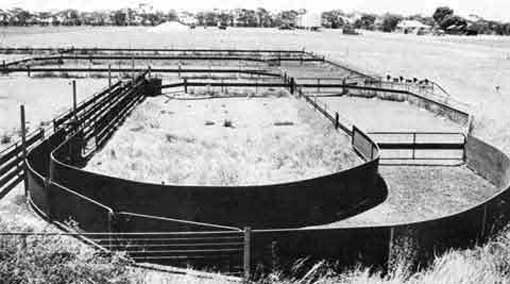
Features
Including the following features will help produce an efficient set of sheep yards.
Large holding areas
These areas can be made of lightweight material to reduce construction costs. However, additional strength is required around gates, where increased pressure is likely to occur.
Wide gates of at least 2.5 m will give easy access from outside the yards, and uninterrupted flow of sheep to the forcing area.
The size and number of holding areas depend on the average mob size run on the farm — for a guide allow 1 sheep per square metre.
Rectangular forcing yards
As sheep prefer to move in mobs these yards are long and narrow to facilitate flow.
The width of forcing yards should be 3–5 m. Yards wider than 6 m substantially reduce control over sheep. The combined length of forcing yards in this design is determined by the length of drafting and working races. Use wide gates and, where possible, avoid sharp or right-angled corners to aid sheep movement.
Circular forcing yard (the ‘bugle’)
This circular forcing pen is the focal point of the whole yard. Sheep become accustomed to the yards, because every time they come in they travel through in the same direction. The same forcing area is used to deliver the sheep into the drafting race, work race, dip or shearing shed.
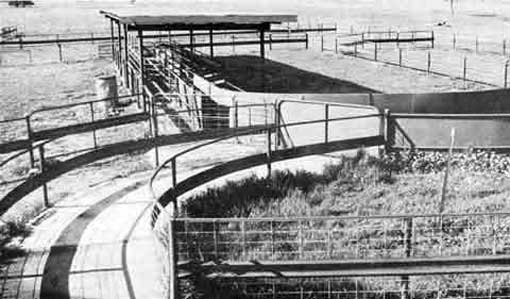
The design narrows from the rectangular forcing yard for the turn into the drafting race. This gives very good control over the sheep in this area by either man or dog.
The inside fence of the bugle should be covered for 5 m back from the start of the draft. This is essential for a number of reasons:
- Sheep can see the mob moving around a corner and tend to follow.
- Sheep are less likely to baulk as they move around the corner towards the operator at the draft.
- When sheep reach the mouth of the drafting race, where they are inclined to baulk, they cannot see the sheep behind and are thus more likely to move forward through the draft.
One of the reasons given for the efficiency of circular yards is that sheep flow back in the direction from which they have come — that is, back to the freedom of their paddock. The bugle facilitates this process.
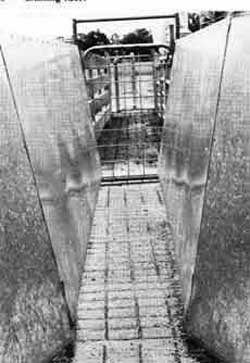
Drafting race
The design of the entrance into the drafting race is crucial. Too much room left on the outside fence will allow the sheep to stand, see the operator, and then turn back. To avoid this, the turn into the drafting race must be reasonably tight — inside radius of 1–1.5 m.
This area should be very solidly built, as it is the most stressed part of the yards. The race should be 3–3.5 m long. If it is any shorter the operator does not have enough time to inspect sheep for drafting; if it is any longer it tends to promote baulking along the race, interrupting sheep flow.
To promote the flow of sheep in single file, the drafting race should be ‘V’ shaped (shown at right). The dimensions will vary slightly depending on the size of the sheep, but for medium-sized Merinos the bottom should be 280 mm wide and the top 550 mm wide, in a race 900 mm high. Both sides of the drafting race should be sheeted in so that sheep cannot see out.
The choice of drafting gates depends on personal preference, but see-through gates are recommended for better sheep flow.
Working race
The working race can be from 10 m to 20 m long and should be about 700 mm wide. To make the sheep readily accessible to the operator the race should not be too high.
Including a double race improves the filling of both races, and cuts down filling time by up to 40%. It can be done by adding one extra fence.
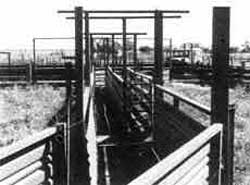
To speed the flow of sheep into the double working race, use a ‘bypass’ race down the side of the drafting race (giving an extra 4 m of working race). Alternatively the outside fence of the drafting race can be made adjustable to increase the width when filling (see Figure 4).
When drafting, the working race is used to deliver the main mob to a holding yard. In some situations, particularly with ewes and lambs, sheep will block at the end of the working race. To overcome this problem extra gates should be added to the working race (see Plan 2), behind the drafting gate. This allows the main mob to be deposited into the yard opposite the forcing area.
In hot climates, covering the working race with a roof will increase operator comfort. The area can also be used to store equipment that is used frequently.
Races longer than 13 m need a block gate halfway along to prevent lambs and weaners packing up and possibly smothering.
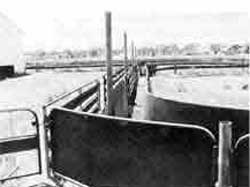
A two-way draft at the end of the working race will often save double handling sheep. For example, when culling or mouthing ewes the mob can be split at the end of the working race, rather than having to be brought back to the drafting race.
‘U’ bugle sheep yard plans
- Plan 1. Set-up with bypass open to allow easier filling of working race
- Plan 2. Set-up for two-way draft (working capacity 800 sheep)
- Plan 3. Working capacity 1600 sheep
Location
Ideally the ‘U’ yard should have the drafting and working race facing north, on the flat or on a slightly uphill slope. Avoid running the races east–west.
If the yards are to feed sheep to the shearing shed, the most appropriate point for them to leave the yard is at the bugle forcing pen, usually via a lane to the shed entry. This aspect needs consideration when laying out the yards.
A well-drained site with an even slope is the best. If this is not available a fill of road base is recommended.
Measurement summary
Sheep density in holding area: 1 sheep per m2.
Sheep density in forcing area: 3 sheep per m2.
| Type | Measure | Metres |
|---|---|---|
| Rectangular forcing yard | Width: | 3–6 |
| Drafting race | Height: | 0.9 |
| Width ‘V’ sides—bottom: | 0.28 | |
| Width ‘V’ sides—top: | 0.55 | |
| Vertical sides: | 0.45 | |
| Length: | 3–3.5 | |
| Drafting gates | Inside radius: | 1.2 |
| Working race | Width: | 0.7 |
| Length: | 10–20 |

